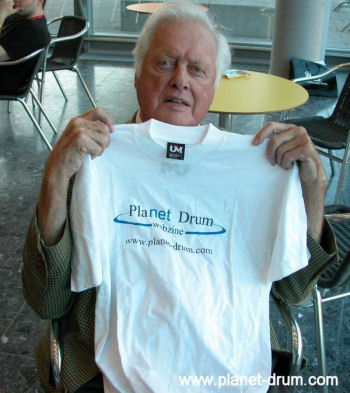Jim Chapin
23 luglio 1919 – 4 luglio 2009

Oggi 4 agosto 2009 siamo esattamente a un mese dalla scomparsa del compianto Jim Chapin.
Era l’ultimo allievo diretto di Sanford A. Moeller e per oltre 60 anni di insegnamento ha continuato a promuovere la così detta “Moeller Technique”. Dal maestro ha assimilato la tecnica e l’ha trasmessa per decenni, con passione e dedizione, a molti professionisti come Dom Famularo, Thomas Lang e migliaia di allievi. Era quasi impossibile vederlo in pubblico, nelle fiere, durante i workshop senza un paio di bacchette in mano, vivace, scattante e pieno di energia.
Ha scritto alcuni metodi fondamentali per la storia dello strumento, come i due volumi delle “Advanced Techniques for the Modern Drummer” ed è stato uno dei batteristi e insegnanti più apprezzati degli ultimi decenni.
Era nato il 23 luglio del 1919 e se n’è andato il 4 luglio del 2009, proprio mentre stava terminando il terzo volume del suo storico e rivoluzionario metodo.
La comunità dei batteristi perde uno dei pilastri della batteria moderna. Nel 1995, ultima di una lunga serie di onoreficenze guadagnate nel corso della sua carriera, era stato ammesso nella Hall of Fame della Percussive Arts Society.
Rob Birenbaum e il suo allievo per eccellenza Dom Famularo lo ricordano così:
Jim Chapin, leggendario batterista jazz ed educatore, è morto il 4 luglio 2009 in Florida. Dopo poche settimane avrebbe compiuto 90 anni.
Mr. Chapin è nato nella città di New York nel 1919. Suo padre era James Ormsbee Chapin, un artista della American Scene School, scuola di pittura e sua madre era Abigail Forbes Chapin, insegnante e scrittrice.
Mr. Chapin ha iniziato a suonare la batteria all’età di 18 anni, dopo essere stato ispirato dal leggendario batterista Gene Krupa. Ha studiato con il celebre “rudimentalista”, Sanford Moeller, e dopo soli due anni ha duettato con Krupa al World’s Fair di New York del 1939!
Nei primi anni 1940, il sig Chapin ha iniziato a lavorare sul metodo di studio per batteria pubblicato nel 1948 con il titolo “Advanced Techniques for the Modern Drummer, Volume I, Coordinated Independence as Applied to Jazz and Be-Bop.” I suoi esercizi e concetti hanno causato tale agitazione tra i batteristi dell’epoca che Jim dovette girare con un paio di bacchette nella tasca posteriore nel caso in cui fosse stato chiamato a dimostrare un passaggio particolarmente difficile o che si potesse veramente suonare ogni pattern scritto nel libro! Ancora oggi in stampa, Il metodo è diventato noto tra i percussionisti semplicemente come “Il libro di Chapin” (“The Chapin Book” )ed è probabilmente il più importante metodo per batteria mai scritto.
Tutti i grandi batteristi degli ultimi 60 anni hanno pagato i diritti d’autore essendo il “The Chapin Book” uno dei metodi più imitati in ambito didattico.
Nel 1971, Mr. Chapin ha pubblicato “Advanced Techniques for the Modern Drummer, Volume II, Independence–The Open End”, una monumentale impresa che utilizza le sovrapposizioni per illustrare la complessità dei suoi punti. Nella prefazione di questo lavoro, il Sig. Chapin ha ammesso che anche lui non poteva suonare ogni pattern presente nel metodo, in modo da ottenere lui il gancio e dover tirare fuori le sue bacchette, su richiesta, per dimostrare che tutto ciò che è stato stampato può effettivamente essere eseguito! Il volume II era circa 40 anni avanti rispetto ai tempi rendendolo, oggi, un metodo moderno!
Dal 1940 sino al 1960, il sig Chapin ha suonato con una serie di gruppi, tra cui Glen Gray e la Casa Loma Orchestra e con gruppi guidati da musicisti del calibro di Mike Riley, Woody Herman, Tommy Dorsey e Tony Pastor. Ha, inoltre, suonato con i suoi figli, Tom, Steve e il suo ultimo genito Harry Chapin, uno dei migliori cantautori degli anni 1970 e uno dei membri fondatori della World Hunger Year, portando la sua band sino agli anni ottanta.
Alcune tecniche di Jim Chapin sono state anche raccolte in un video didattico pubblicato per la prima volta nel 1992 con il titolo “Speed, Power, Control, Endurance” e che è ora disponibile anche in DVD. Sebbene la maggior parte delle persone si aspetterebbe un DVD dove poter ammirare Mr. Chapin seduto dietro il suo drum set a suonare tutti i più complicati pattern presenti nei suoi libri, in realtà Jim Chapin spende tutto il tempo su un practice pad, dimostrando la tecnica del suo maestro, Sanford Moeller, di cui egli è stato un evangelico seguace e al quale ha attribuito la sua longevità come batterista. Era la sua missione ottenere il maggior numero possibile di batteristi in grado di utilizzare il metodo Moeller per ottenere il massimo dei risultati dal minimo sforzo, evitando così la fatica e gli infortuni.
Nel corso degli ultimi 25 anni il signor Chapin ha trovato una seconda carriera. Riscoperto da una nuova generazione di musicisti affamati di nozioni lo hanno eletto a maestro per la sua profonda conoscenza della batteria e dei batteristi. Jim Chapin ha trascorso il suo tempo viaggiando in tutto il mondo insegnando e presentando seminari, oltre che essere un appuntamento fisso alle fiere e conventions di musica e percussioni. Era un Pied Piper dei tamburi e tutto ciò che Mr. Chapin doveva fare era sedersi dietro il suo martoriato, ma sempre a portata di mano practice pad, che in qualsiasi parte del mondo una folla di percussionisti si sarebbe riunita ad ammirare e assimilare al massimo ciò che il suo studente,namico e confidente Dom Famularo ha rinominato come “The Chapin Magic”.
Nel 1994, Mr. Chapin ha ricevuto due riconoscimenti per il suo contributo alla musica e l’istruzione: l’American Eagle Award, presentato dal Consiglio Nazionale della Musica a Washington e un Lifetime Achievement Award dal Berklee College of Music di Boston. Nel 1995 è entrato a far parte della Percussive Arts Society Hall of Fame. Nel corso degli ultimi 70 anni, ha osservato, studiato e analizzato ogni grande (e non tanto grande) batterista. Era lì da quasi l’inizio della moderna batteria e ciò non potrà mai accadere di nuovo. Mr. Chapin è stato uno studente modello e un maestro eccellente, personificando le più importanti qualità necessarie per la longevità nel music business: egli non è mai invecchiato!

ENGLISH VERSION
Jim Chapin, legendary jazz drummer and educator, died on July 4, 2009 in Florida. He was a few weeks shy of 90 years old.
Mr. Chapin was born in New York City in 1919. His father was James Ormsbee Chapin, an artist of the American Scene school of painting and his mother was Abigail Forbes Chapin, a teacher and writer.
Mr. Chapin did not begin playing the drums until he was 18 years old, after being inspired by legendary drummer Gene Krupa. He studied with the renowned rudimentalist, Sanford Moeller, and within two years he was playing opposite Krupa at the 1939 World’s Fair in New York!
In the early 1940s, Mr. Chapin began working on a drum instruction book that was eventually published in 1948 as “Advanced Techniques for the Modern Drummer, Volume I, Coordinated Independence as Applied to Jazz and Be-Bop.” His exercises and concepts caused such a stir among drummers that he had to have a pair of drumsticks in his back pocket at all times in case he was called upon to demonstrate a particularly difficult passage and to prove that he truly could play every pattern in the book! Still in print today, it became known among drummers simply as “The Chapin Book” and is arguably the most important drum set text ever written.
All of the great drummers in the past 60 years have paid their dues with The Chapin Book, which is the much-imitated, standard work on the subject. In 1971, Mr. Chapin published “Advanced Techniques for the Modern Drummer, Volume II, Independence–The Open End”, a monumental undertaking that utilizes overlays to illustrate its complex points. In the preface of this work, Mr. Chapin admitted that even he could not play every pattern that is presented, thus getting him off the hook of having to pull out his sticks on demand to prove that everything printed can actually be executed! Volume II was ahead of its time nearly 40 years ago and it is modern today!
From the 1940s through the 1960s, Mr. Chapin performed and toured with a variety of bands, including Glen Gray and the Casa Loma Orchestra and groups led by the likes of Mike Riley, Woody Herman, Tommy Dorsey and Tony Pastor. He also performed on occasion with his sons, Tom, Steve and the late Harry Chapin who was one of the top singer-songwriters of the 1970s and a founding member of the World Hunger Year. And he led his own bands well into his 80s.
Some of Mr. Chapin’s techniques were captured on an instructional video first released in 1992 called “Speed, Power, Control, Endurance”, which is now available on DVD. Though most would expect the video to feature him playing complex patterns from his books on a drum set, Mr. Chapin spent the entire time on a practice pad, demonstrating the methods of his instructor, Sanford Moeller, of which he was evangelistic about and to which he attributed his longevity as a drummer. It was Mr. Chapin’s mission to get as many drummers as possible to utilize The Moeller Method to get the maximum results from the minimum effort, thus avoiding fatigue and injuries.
During the past 25 years, Mr. Chapin found a second career, as he was discovered by a new generation of musicians that hungered for his depth of knowledge on drummers and drumming. He spent his time travelling around the world teaching and presenting seminars and he was a fixture at music trade shows and percussion conventions. He was a Pied Piper of drumming and all Mr. Chapin had to do was sit down at his battered and always handy practice pad anywhere in the world and a crowd of drummers would gather to soak in as much of what long-time student, friend and confidant Dom Famularo aptly dubbed as “The Chapin Magic”.
In 1994, Mr. Chapin received two honors for his contributions to music and education: the American Eagle Award, presented by the National Music Council in Washington and a lifetime achievement award from the Berklee College of Music in Boston. And in 1995, he was inducted into the Percussive Arts Society Hall of Fame.
Through times of “here today-gone tomorrow” artists, Mr. Chapin was always there. During the past 70 years, he observed, studied and analyzed every great (and not so great) drummer. He was there almost from the beginning of modern drum set playing and that will never happen again. Mr. Chapin was a master student in addition to being a master teacher and he epitomized the most important quality necessary for longevity in the music business: he would not grow old!
{jcomments on}


